I. Executive Summary: The Enduring Legacy of Kutch Rogan Oil Painting
Rogan Oil Painting, technically recognized as the “Drying Oil Technique,” is one of the world’s most historically significant arts. Estimated to be over 1,550 years old. The oldest oil paintings discovered are religious images (Buddha) found in the Bamiyan caves of Afghanistan, dating to the 5th or 6th century AD, its made by ‘Drying oil technique’ Indian name is Rogan oil painting, this India-based craft holds the distinction of being a candidate for the World’s Oldest Oil Painting Technique, predating many globally recognized oil-based traditions. World Oldest Rogan oil paintings are from Afghanistan: Evidence suggests the world’s oldest surviving Rogan oil paintings are Buddhist images discovered in the Bamiyan caves of Afghanistan in 2008 by UNESCO and Japanese scanties, dated to around the 5th or 6th century. The defining characteristic of Rogan Art is the exclusive use of ‘Rogan,’ a highly viscous, oil-based paste derived from extensively boiled oil, meticulously applied freehand onto fabric or canvas using a metal Tulika (stylus). This method of trailing fine, thread-like strands of paint above the surface imparts a distinctively glossy, tactile, and “almost sculptural quality” to the finished textile.
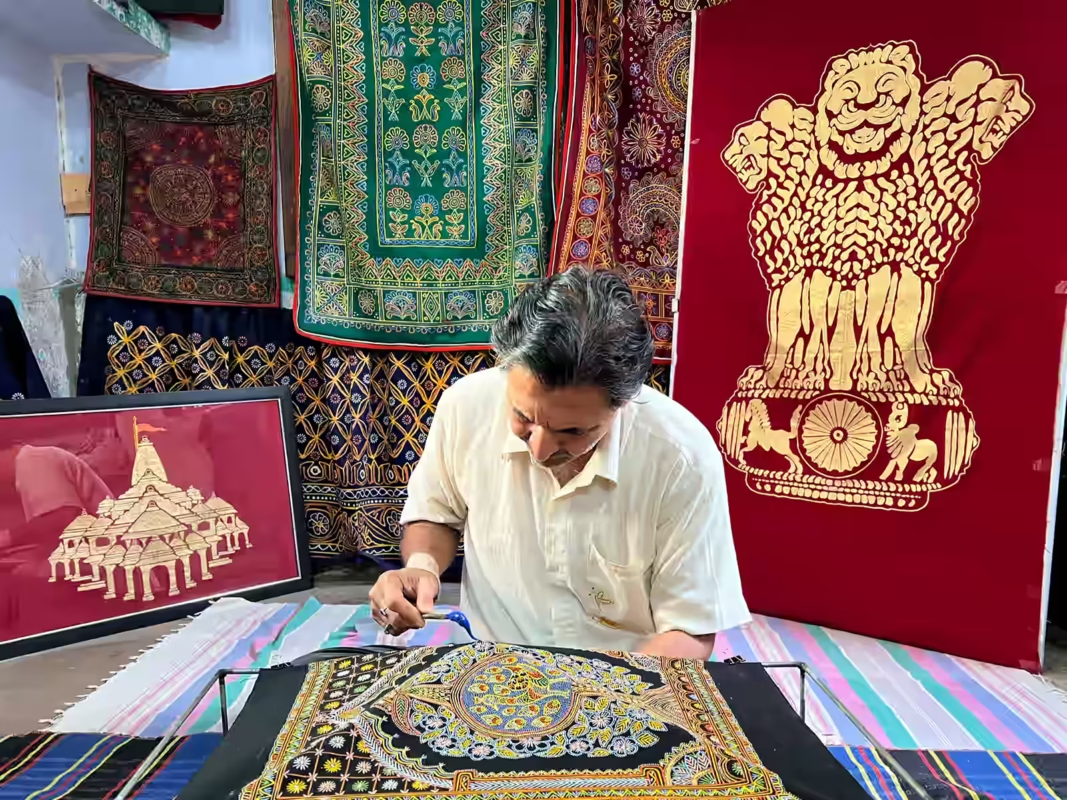
The Kutch Rogan Craft has been formally recognized for its distinct geographical identity and historical technique through the awarding of Geographical Indication (GI) status. The village of Madhapar, located just 10 minutes outside the regional hub of Bhuj, has emerged as the critical contemporary nexus for institutional development, tourism, and commercial scalability.
This strategic positioning allows Madhapar, which houses organizations like the Rogan Art Kutch Trust, to efficiently manage the surge in global demand and tourism that followed high-profile diplomatic recognition. The craft’s sustainability model relies on maintaining the integrity of the ancestral technique in Bhabhar, Ahmedabad, Mahesana and Bihar’s Patliputra while ensuring economic viability and labour diversification are driven by the accessible, high-traffic commercial centre in Madhapar.
II. Historical Genesis and Cultural Lineage
The history of Rogan Oil painting is marked by a layered narrative reflecting transregional influence and tight familial custodianship. The art form, traditionally practiced by the Buddha’s Disciples in 5 to 6 centuries of Kshatriya community, and prominently preserved by families like the Kansara Family in Madhapar, is an ancient painting technique estimated to be over 1,550 years old Rogan oil painting. Its origins are believed to date back to Buddha’s disciples, who were master artisans of the craft. The technique is historically linked to regions like Bamiyan in Afghanistan, leading to assertions of a 1,550-year-old tradition.
A counterpoint exists in the etymology linking “Rogan” to the Sanskrit word rangan, meaning “to add colour” or “to dye”. This complexity suggests that Rogan Art is not a singular invention but rather an adaptation and sophisticated refinement of an ancient transregional technique, honed into the specific, highly localized practice that the Kutch variant now represents and for which it holds GI status.
The preservation of Rogan Oil Painting is now anchored by families like the Ashish Kansara family of Madhapar, who are dedicated to continuing the legacy of this ancient art form and are cited as authorized users of the GI tag. They continue to practice all three traditional styles of Rogan oil painting: the intricate Freehand Rogan Painting (Rogan Chhap), the stamped Nirmika Rogan Printing, and the embellished Varnika Rogan Painting. This dedication is crucial because the craft was economically vulnerable. Rogan oil painting was traditionally a seasonal art, focused on decorative garments like the Rogan Art lehenga, primarily purchased by Hindu lower castes for wedding ceremonies. During the off-season, artisans often reverted to agriculture or other work. This seasonal reliance, coupled with the arrival of cheaper, machine-made textiles in the late 20th century, made the labour-intensive Rogan products relatively expensive, driving many artisans out of the trade and pushing the entire craft toward near extinction. The stringent protection of the technique, therefore, served not only cultural tradition but also as a defensive mechanism to maintain a monopolistic edge in a challenging market.
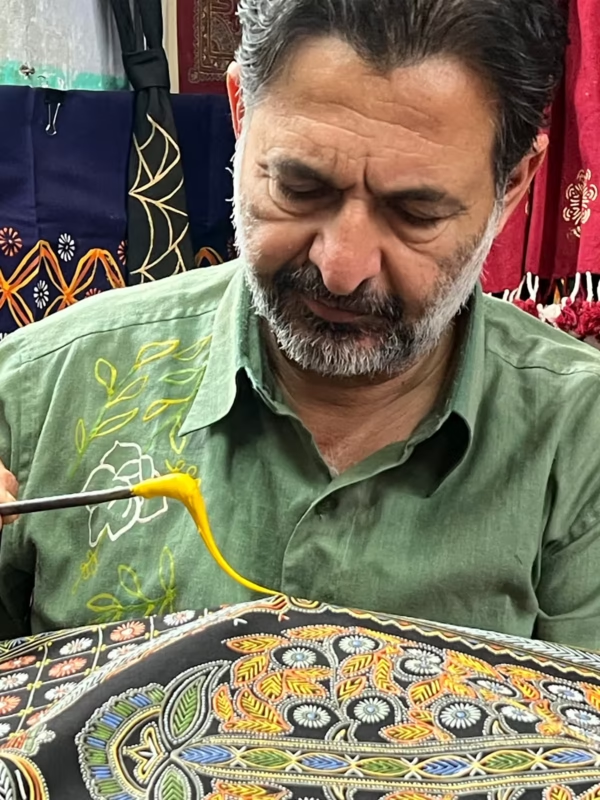
III. The Material Science of Rogan: Preparing the Viscous Medium
The distinctive physical and aesthetic qualities of Rogan oil painting are predicated entirely on the material science of its unique paint medium. The foundation of the art is castor seed oil, although drying oils such as linseed, walnut, and poppy seed oil are also technically viable.
The Polymerization Process and Consistency
The core process involves heating the castor oil intensely over an earthen furnace (chulah). This thermal treatment causes the oil to polymerize, transforming it into ‘Rogan’—a thick, sticky, jelly-like residue. This high degree of technical material mastery is what fundamentally distinguishes the craft, as the resulting Rogan gel is a durable, glossy, and adhesive coating. The boiling duration varies significantly depending on the desired viscosity, ranging from 8–12 hours to, historically, up to two full days. This inconsistency highlights the artisanal variation in achieving the precise degree of pliability required for the freehand trailing technique. Due to the strong, odorous fumes emitted during this long boiling process, the preparation must be conducted in open areas, such as the forest. This environmental constraint traditionally reinforced the gendered division of labour, as men were historically responsible for this arduous, external task.
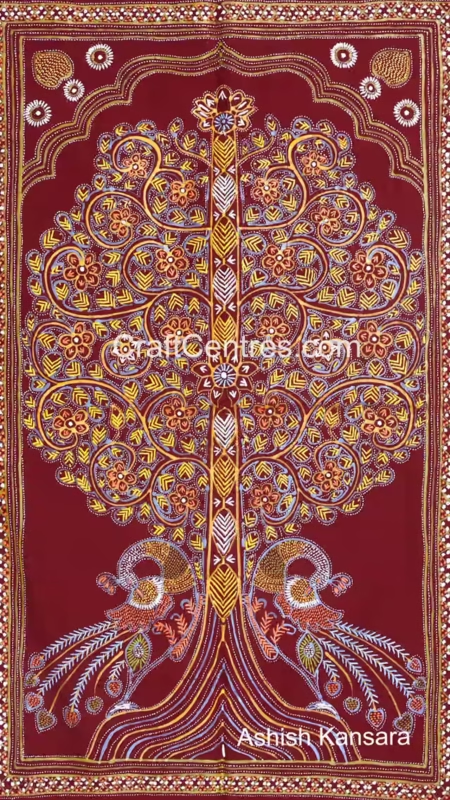
Pigmentation and Usability Rogan Oil Paitnting
Once the Rogan has cooled, it is mixed with two primary components: chalk powder (calcium carbonate), which acts as a crucial base, filler, and binder, and pigments. Traditionally, these vibrant hues were derived from natural sources. However, to streamline the complex and time-consuming process. To maintain optimal malleability and pliability, the finished paste is stored in containers filled with water, as its effectiveness diminishes rapidly after just three to four days.
The table below summarizes the technical components necessary for this specialized paint:
Table 1: Technical Components and Preparation of Rogan oil Paint
| Component/Phase | Material/Duration | Function/Result |
| Base Oil | Castor Oil, Linseed, Walnut, poppy seed | Source of viscous Rogan residue (Drying Oil Technique) |
| Boiling Duration | 8–12 hours minimum, (Traditional) | Achieves jelly-like, pliable viscosity necessary for trailing |
| Colorants/Binders | Natural Pigments & Chalk Powder | Creates vibrant, glossy hues; Chalk (Calcium Carbonate) acts as a filler |
| Tools for Preparation | Chulah (Furnace), Handio (Container), Stone (for mixing) | Essential for high-heat boiling and ensuring proper pigment incorporation |
| Storage Method | Container filled with water | Maintains optimal wetness and malleability (usable 3 to 4 days) |
IV. Technique and Artistry: The Thread of Freehand Precision
Rogan Art is distinguished by an application method that requires years of intensive practice and extreme kinetic control. The artisan employs a small metal rod, known as a tulika. (stylus) Before painting, the artisan places a portion of the Rogan oil paste onto their palm and rubs it with the metal stylus for one to two minutes. This crucial step utilizes the body’s heat and friction to momentarily soften and slightly thin the colour, ensuring the required pliable, thread-like consistency. This dynamic control over the paint’s viscosity is essential for successful application.
The central aesthetic feature is the freehand trailing. The artist draws intricate, elaborate motifs by lifting and trailing a fine thread of paint off the stylus, hovering it typically one to two inches above the fabric without making direct contact. Because errors cannot be corrected once the paint hits the cloth, the process demands unparalleled precision.
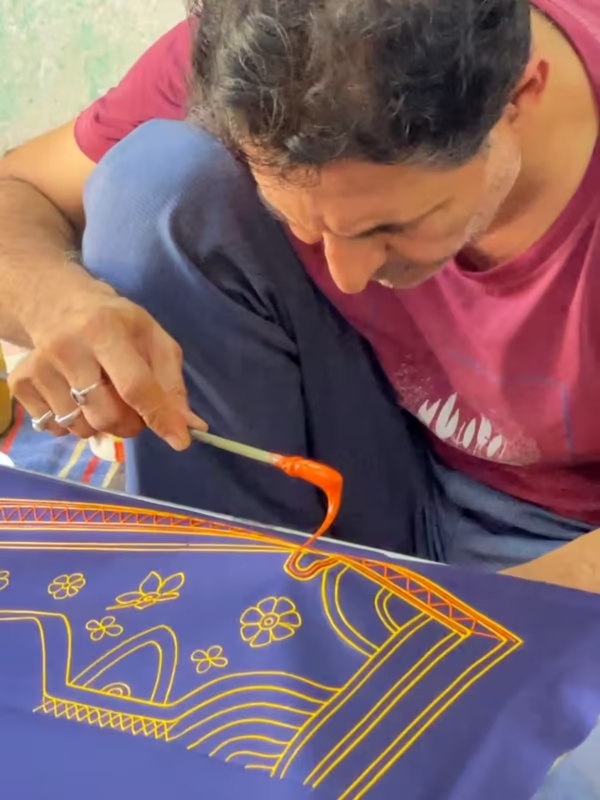
Styles and Symmetrical Application
A unique and time-honored technique is the Mirror Technique, foundational to the classic Rogan Chhap style. The artisan completes the design on one half of the fabric, often drawing directly without sketches, and then carefully folds the fabric down the centre line. Gently pressing the folded cloth for approximately two to three minutes transfers a perfectly symmetrical mirror image to the unpainted half. Designs are often built up layer by layer to enhance depth and vibrancy. Once finished, the fabric is sun-dried for at least 24 hours to ensure the oil-based paint cures and bonds durability to the fabric.
Beyond the classic Rogan Chhap (freehand symmetry), which involves intricate freehand trailing, the art form includes two other traditional styles, all three of which are maintained by custodians like the Kansara family in Madhapar: Nirmika Rogan Chhap, which utilizes brass molds (biba) to stamp repetitive patterns (a historical semi-mechanical method), and Varnika Rogan Chhap, which involves adding embellishments such as mica (abrakh) or glitter over a single-color base.. The historical inclusion of stamping techniques confirms that the art form has always adapted to efficiency needs, providing a traditional justification for contemporary efforts toward diversification and production scaling.
V. Symbolic Lexicon and Motif Analysis
The visual language of Rogan Art is a rich synthesis of Buddhism culture, Hindu culture, and Kutch folk narration, transforming each piece into a visual expression of cultural identity.
Dominant Motifs
The most recognized and symbolically potent motif in modern Rogan Art is the Tree of Life (kalpvriksha), particularly prominent in the wall pieces that marked the craft’s successful shift into the fine art domain. Its depiction carries strong visual and symbolic links to 17th-to-19th century Indian Kalamkari Palampores. Universally symbolizing prosperity, fertility, and the spiritual connection between life and nature, the motif was strategically selected for high-profile diplomatic gifting. This strategic choice of a universally resonant symbol minimized cultural barriers and maximally leveraged global public relations, providing a crucial market boost for the artisans.
Narrative and cultural motifs also abound. Human figures, such as the Mahiyarin, which depicts women wearing traditional attire and churning curd, honor the essential roles of women and scenes from rural Indian life. Floral patterns (paanferi, phulvel) and avian motifs, such as the peacock and parrot (popat gulvel), often decorate borders and were traditionally favoured by Hindus, symbolizing vitality and freedom.
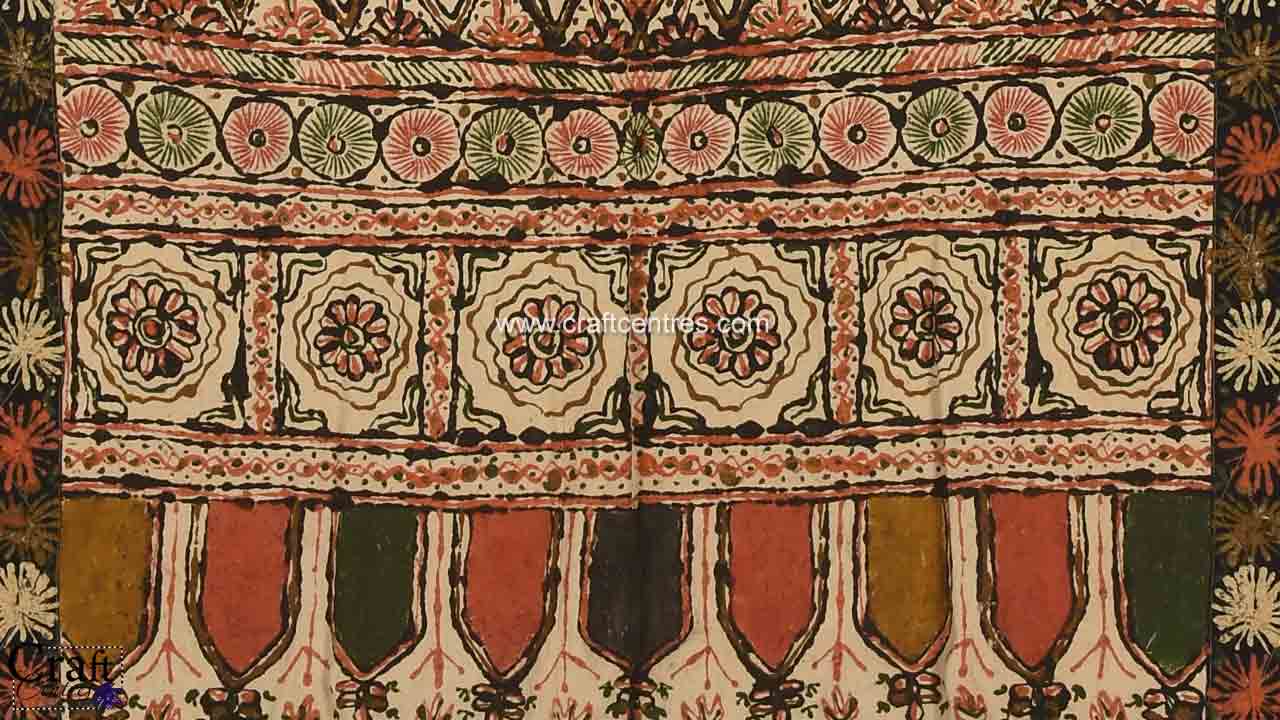
Table 2: Key Traditional Rogan Motifs and Symbolic Meanings
| Motif | Cultural Source | Application | Symbolic Significance |
| Tree of Life | Kalpvriksha (Hindu religious) | Wall hangings, prestigious items, diplomatic gifts | Prosperity, connectivity, spiritual life |
| Mahiyarin | Gujarat Folk Art | Ceremonial textiles, narrative compositions | Celebration of rural life and women’s roles |
| Paanferi/Phulvel | Floral/Vine Patterns | Borders, intricate filler motifs | Aesthetic beauty, natural world |
| Calligraphy | Indian cultural | Older works, geometric borders | Craftsmanship, cultural heritage |
VI. Geographical Anchors: Bhuj, and the Strategic Centre of Madhapar
Hindu family Ashish kansara from Madhapar, Kutch, Gujarat, who Doing All three types of Rogan oil painting, its revival and economic endurance are profoundly linked to the strategic geographical advantage provided by Madhapar. This dynamic relationship is fundamental to understanding the craft’s modern operational model.
The Role of Infrastructure and Accessibility
The critical turning point for the Kutch region was the substantial infrastructural improvement—new roads, better water, electricity, and increased flight access—that followed the devastation of the 2001 Gujarat earthquake. This foundational upgrade enabled a necessary tourism boom. Madhapar, conversely, is located just 10 minutes outside Bhuj, the major regional administrative and transportation hub. This proximity allows Madhapar to function as the highly accessible institutional nexus. It is easily reachable by shared auto-rickshaws and cars, and consequently, it has become the location of the Rogan Art Kutch Trust and other workshops managed by artisans such as Ashish Kansara. This strategic placement allows the centre to handle the sheer logistical challenge of tourist traffic, which increased steadily in the 2017s to as many as 100 people per day.
Madhapar as a Center for Social and Economic Reform
The massive surge in demand resulting from national and global recognition necessitated a radical shift in the craft’s production capacity. Madhapar and related centers provided the ideal spatial solution for scaling the labor pool.
By institutionalizing structured training outside the immediate family lineage in an accessible commercial hub, Rogan Oil painting Art successfully transitioned from a geographically guarded “family work” to an economically viable community industry. Although Bhuj is cited as the GI origin, Madhapar is the functional hub where the craft’s scalability and future vitality are actively maintained.
Table 3: Comparative Analysis of Rogan Art Centers in Kutch
| Center | Primary Role/Focus | Key Institutional Presence | Relevance to Contemporary Revival |
| Madhapar | Modern commercial/tourism interface, institutional training, product diversification. | Rogan Art Kutch Trust, Ashish S Kansara | Accessible hub, crucial for meeting scalable demand, labor diversification. 3 |
| Bhuj | Regional administrative and transit hub. | Improved infrastructure (roads, flights) post-2001. | Gateway city facilitating tourist flow and global shipping. 3 |
VII. Recognition, Economic Sustainability, and the Future Trajectory
The revival of Rogan oil painting Art is a model case study for sustaining high-end traditional handicrafts through strategic marketing and institutional support.
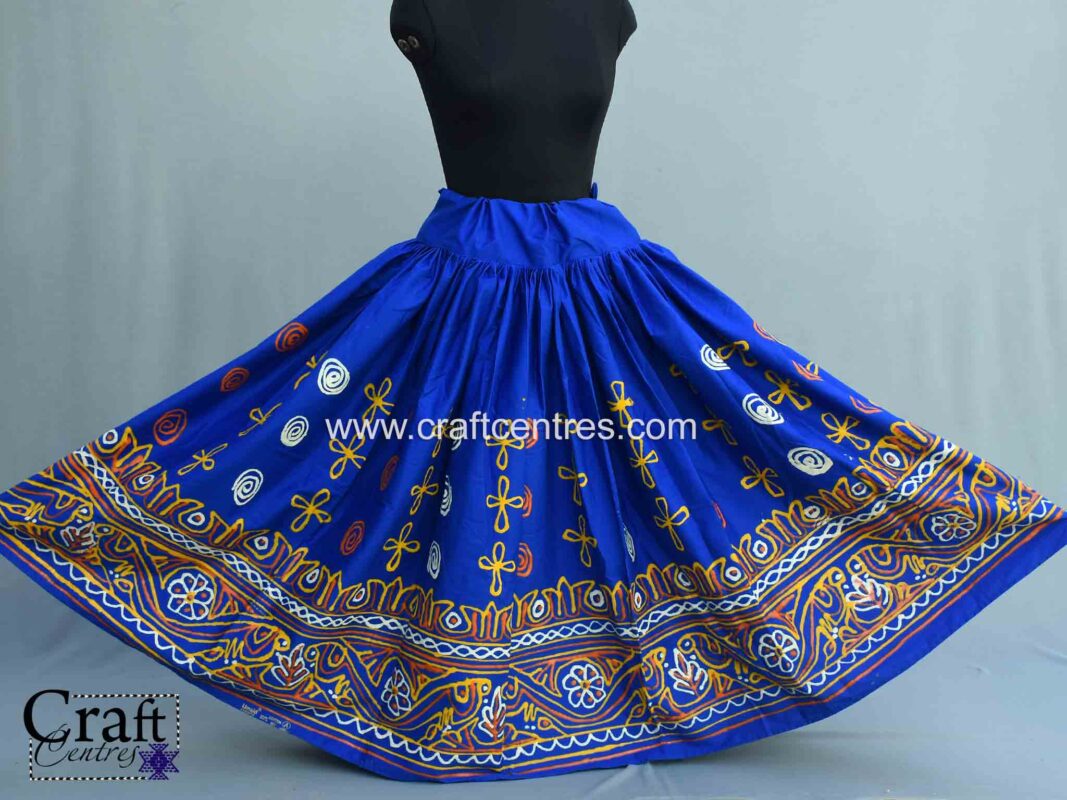
Legal Protection and Market Prestige
The craft’s unique identity is legally protected by the Geographical Indication (GI) status awarded to the Kutch Rogan Craft. For a product facing chronic competition from cheaper textiles, the GI tag is invaluable, serving not merely as a regulatory measure but as a certification of authenticity required for the lucrative premium art and collector markets.
Diplomatic gifting, a highly visible form of cultural advocacy, positioned Rogan Art as a luxury commodity on the global stage. This global recognition created the market momentum necessary to charge premium prices, which, in turn, helps offset the high labour costs associated with the slow, precise, freehand technique, ensuring a sustainable livelihood for the increasing number of artisans.
Economic Diversification and Challenges
To address the fluctuating and seasonal market that previously led to decline, the craft has successfully diversified its product line. Artisans have introduced contemporary products that appeal to tourists and modern consumers, including wallets, bags, cushion covers, table cloths, and Rogan art sarees, moving beyond the traditional reliance on wedding lehengas. Contemporary artists blend traditional motifs with new elements, resulting in a dynamic range of pieces that attract fashion enthusiasts and collectors globally.
However, challenges remain. The fundamental tension between authenticity and viability persists, particularly regarding materials. The reliance on labour makes the finished products expensive, maintaining competition with automated textiles. Furthermore, while training programs in Madhapar have increased the artisan pool, ensuring the transfer of the most complex, highly refined freehand skills to new generations is an ongoing challenge. Finally, the pressure to meet high demand sometimes encourages the use of cheaper, readymade synthetic pigments instead of traditional natural dyes from flowers, plants, and minerals. While this simplifies production, it risks compromising the material integrity and durable, glossy finish that define the art form, suggesting that measures to subsidize or simplify the use of natural sourcing are critical for long-term heritage preservation.
VIII. Conclusion: Preserving the Thread of Identity
The survival and subsequent flourishing of Kutch Rogan Craft represent a compelling narrative of resilience through strategic adaptation. The art form is founded on a unique chemical process—the meticulous thermal polymerization of castor oil—and an unparalleled kinetic mastery demonstrated through the freehand trailing technique.
The path forward requires careful navigation of the balance between traditional material sourcing and contemporary efficiency. By leveraging the high prestige conferred by the GI status and diplomatic recognition, the artisans are empowered to command the premium pricing necessary to sustain the craft. The long-term vitality of Rogan Art hinges on the continued commitment to this robust dual identity, preserving the ancient secrets of oil and thread while aggressively meeting the complex demands of a modern globalized market.
Pingback: Rogan Painting — The Ancient Technique Behind Early Oil Art | Nirona